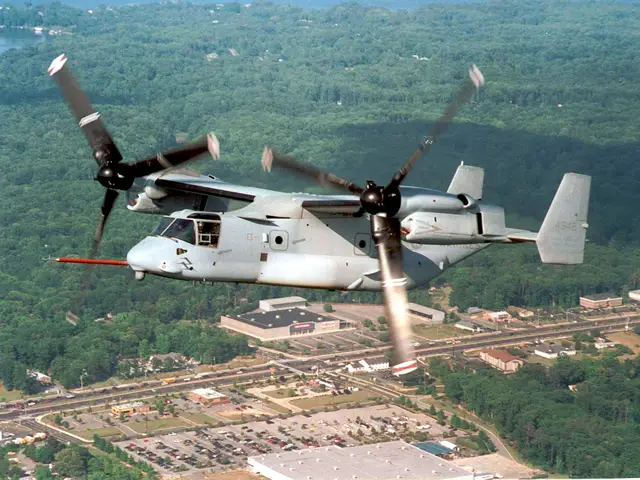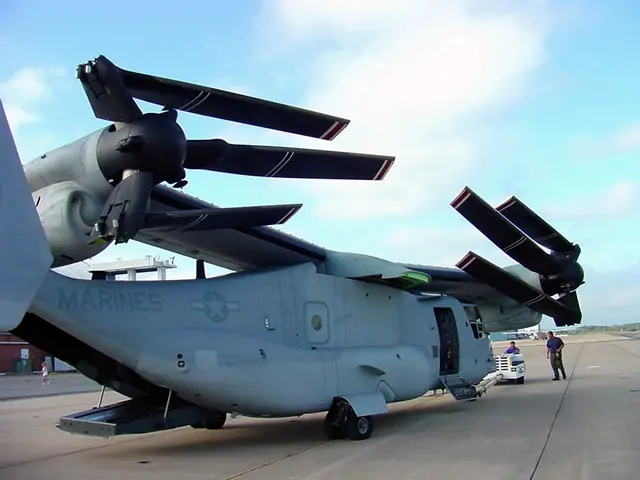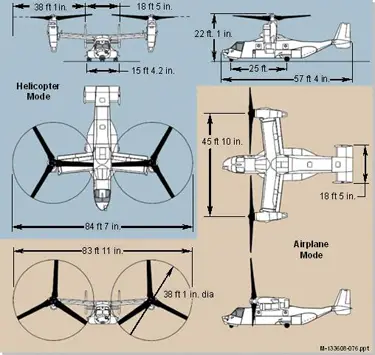The Bell Boeing V-22 Osprey is an American multi-mission, tiltrotor military aircraft with both a vertical takeoff and landing (VTOL), and short takeoff and landing (STOL) capability. It is designed to combine the functionality of a conventional helicopter with the long-range, high-speed cruise performance of a turboprop aircraft.
The V-22 Osprey developed by Boeing and Bell Helicopters. Boeing is responsible for the fuselage, landing gear, avionics, electrical and hydraulic systems, performance and flying qualities.
Bell Helicopter Textron is responsible for the wing and nacelle, propulsion, rotor, empennage (complete tail system), ramp, overwing fairing and the dynamics.
The V-22 originated from the United States Department of Defense Joint-service Vertical take-off/landing Experimental (JVX) aircraft program started in 1981. The V-22 first flew in 1989, and began flight testing and design alterations; the complexity and difficulties of being the first tiltrotor intended for military service in the world led to many years of development.
The United States Marine Corps began crew training for the Osprey in 2000, and fielded it in 2007; it supplemented and then replaced their Boeing Vertol CH-46 Sea Knights. The Osprey's other operator, the U.S. Air Force, fielded their version of the tiltrotor in 2009. Since entering service with the U.S. Marine Corps and Air Force, the Osprey has been deployed in transportation and medivac operations over Iraq, Afghanistan, Libya and Kuwait.
The V-22 Osprey can carry 24 combat troops, or up to 20,000 pounds of internal cargo or 15,000 pounds of external cargo, at twice the speed of a helicopter. It features a cross-coupled drive system so either engine can power the rotors if one engine fails. For shipboard compatibility, the rotors fold and the wing rotates to minimize the aircraft’s footprint for storage.
The U.S. Marine Corps has a current requirement for 360 MV- 22s to perform combat assault and assault support missions. The U.S. Air Force Special Operations Command has a requirement for 50 CV-22s configured for terrain-following, low-level, high-speed flight for long range special operations. More than 200 Osprey tiltrotors are currently in operation across 10 Marine Corps and two Air Force Special Operations Command (AFSOC) Osprey squadrons.
Development
The failure of the Iran hostage rescue mission in 1980 demonstrated to the United States military a need for "a new type of aircraft, that could not only take off and land vertically but also could carry combat troops, and do so at speed." The U.S. Department of Defense began the Joint-service Vertical take-off/landing Experimental (JVX) aircraft program in 1981, under U.S. Army leadership.
The U.S. Navy and Marine Corps were given the lead in 1983. The JVX combined requirements from the U.S. Marine Corps, Air Force, Army and Navy. A request for proposals (RFP) was issued in December 1982 for preliminary design work. Interest was expressed by Aérospatiale, Bell Helicopter, Boeing Vertol, Grumman, Lockheed, and Westland. Contractors were encouraged to form teams. Bell partnered with Boeing Vertol to submit a proposal for an enlarged version of the Bell XV-15 prototype on 17 February 1983. Being the only proposal received, a preliminary design contract was awarded on 26 April 1983.
The JVX aircraft was designated V-22 Osprey on 15 January 1985; by that March, the first six prototypes were being produced, and Boeing Vertol was expanded to deal with the project workload. Six prototypes were produced and flight-testing started in 1989, but the programme suffered a serious setback in 1992 with the crash of the fourth prototype. Already under financial and political review, a serious reappraisal of the Osprey programme followed, with the ultimate conclusion that 300 (later 360) aircraft would be acquired for the US Marine Corps only.
In 1994 production authorisation was granted for this batch, plus 48 Ospreys for the US Navy and 50 for the US Air Force. The loss of three V-22s during testing in 2000 cast a further shadow over the programme, but this most important of future combat aircraft reached initial operatrional capability with the US Marine Corps during 2001-2002. Pre-production deliveries to the US Air Force and US Navy started in 2003. Finally the Osprey was officially adopted and its full-scale production began in 2007. The initial production rate was 11 machines per year, which was stepped up to 24-48 machines per year by 2012. Since its introduction the Osprey complemented the fleet of the US forces helicopters. The V-22 Osprey will replace IAF's ageing fleet of Sikorsky CH-53 Sea Stallion transport helicopters.
Design
The V-22 Osprey is the world's first production tiltrotor aircraft, with one three-bladed proprotor, turboprop engine, and transmission nacelle mounted on each wingtip. It is classified as a powered lift aircraft by the Federal Aviation Administration. For takeoff and landing, it typically operates as a helicopter with the nacelles vertical and rotors horizontal. Once airborne, the nacelles rotate forward 90° in as little as 12 seconds for horizontal flight, converting the V-22 to a more fuel-efficient, higher speed turboprop aircraft. STOL rolling-takeoff and landing capability is achieved by having the nacelles tilted forward up to 45°. Other orientations are possible. It has a ferry range of over 2,100 nmi. Its operational range is 1,100 nmi.
The V-22 Osprey is fully shipboard compatible, with the world's first complete blade fold and wing stowage system. It is able to operate off all US Navy L-class amphibious ships, the LHA/LHD assault carriers, and can be stowed on full-size CV/CVN carriers.
Cockpit
The V-22 Osprey is equipped with a glass cockpit, which incorporates four Multi-function displays (MFDs, compatible with night-vision goggles) and one shared Central Display Unit (CDU), to display various images including: digimaps, imagery from the Turreted Forward Looking Infrared System primary flight instruments, navigation (TACAN, VOR, ILS, GPS, INS), and system status. The flight director panel of the Cockpit Management System (CMS) allows for fully coupled (autopilot) functions that take the aircraft from forward flight into a 50 ft (15 m) hover with no pilot interaction other than programming the system. The glass cockpit of the canceled CH-46X was derived from the V-22. The fuselage is not pressurized, and personnel must wear on-board oxygen masks above 10,000 feet.
The V-22 Osprey has triple-redundant fly-by-wire flight control systems. The aircraft also has computerized damage control that automatically isolates damaged elements. With the nacelles pointing straight up in conversion mode at 90° the flight computers command the aircraft to fly like a helicopter, with cyclic forces being applied to a conventional swashplate at the rotor hub. With the nacelles in airplane mode (0°) the flaperons, rudder, and elevator fly the aircraft like an airplane. This is a gradual transition and occurs over the rotation range of the nacelles. The lower the nacelles, the greater effect of the airplane-mode control surfaces. The nacelles can rotate past vertical to 97.5° for rearward flight. The V-22 can use the "80 Jump" orientation with the nacelles at 80° for takeoff to quickly achieve high altitude and speed. Aspects of the V-22's flight are automated and simplified by the control system such that the V-22 Osprey can hover (in low wind) with no hands on the controls. According to some who have flown the aircraft, former fixed-wing pilots may be preferable because they (unlike those with helicopter experience) are not trained to constantly adjust the controls while hovering.
The standby altitude indicator and the standby flight display are supplied by Smiths Industries. The cabin and the cockpit are NBC (nuclear, biological and chemical warfare) protected with a positive pressure filtered air system.
Sensors
The US Air Force and US Navy variants are equipped with a Raytheon AN/APQ-186 terrain-following, multimode radar. The helicopter night-vision system is the Raytheon AN/AAQ-16 (V-22) FLIR, which is mounted on the nose. This system contains a 3-5 micron indium antimonide staring focal plane array.
Countermeasures
The aircraft's electronic warfare suite includes the ATK AN/AAR-47 missile warning system, which consists of four electro-optic sensors with photomultipliers, a signal processing unit and a cockpit display.
The aircraft is also equipped with a radar and infrared threat warning system and chaff and flare dispensers with 60 rounds of dispensables.
The CV-22 features the suite of integrated radio frequency measures (SIRFC) developed by ITT Avionics.
Armament
The V-22 Osprey can be armed with one 7.62×51mm NATO (.308 in caliber) M240 machine gun or .50 in caliber (12.7 mm) M2 machine gun on the loading ramp, that can be fired rearward when the ramp is lowered. A .50 in GAU-19 three-barrel Gatling gun mounted below the V-22's nose was studied for future upgrade. BAE Systems developed a belly-mounted, remotely operated gun turret system for the V-22 Osprey, named the Interim Defense Weapon System (IDWS). The IDWS is remotely operated by a gunner inside the aircraft, who acquires targets via a separate pod using color television and forward looking infrared imagery. The IDWS was installed on half of the first V-22s deployed to Afghanistan in 2009, but found limited use due to its 800 lb (360 kg) weight and restrictive rules of engagement.
In 2014, the USMC revealed plans for new V-22 weapons "to increase all-axis, stand-off, and precision capabilities", which may be potentially operated by additional crew members. Armament increases are for enhanced offensive capabilities to special purpose Marine rapid crisis response task forces, rather than as an attack platform. The V-22 Osprey could be adapted for various precision weapons, including the AGM-114 Hellfire, AGM-176 Griffin, Joint Air-to-Ground Missile, and GBU-53/B SDB II. Fuselage-based hardpoints would be used to clear the proprotors. In November 2014, Bell and Boeing conducted self-funded weapons tests using a V-22 Osprey equipped with a small pylon on the front port-side fuselage and the AN/AAQ-27A EO camera replaced with an L-3 Wescam MX-15 sensor/laser designator. 26 unguided Hydra 70 rockets, two guided APKWS rockets, and two Griffin B missiles were fired over five flights. The USMC and USAF seek a traversable nose-mounted weapon connected to a helmet-mounted sight; recoil would complicate integrating a desired forward-facing gun. A weapons pylon on either side of the fuselage can carry 300 lb (140 kg) of munitions.
Engines
The aircraft is powered by two Rolls-Royce AE1107C turboshaft engines rated at 4,586kW maximum continuous power.
The engines are fitted with full-authority digital electronic control (FADEC) supplied by Lucas Aerospace, backup analog electronic control system, and fire protection system from Systron Donner.
A transmission interconnect shaft provides single-engine operation. The thermal signature of the aircraft is minimised with an AiResearch infrared emission suppression unit, installed on the nacelles near the engine exhaust.
The entire rotor, transmission and engine nacelles tilt through 90° in forward rotation and are directed forwards for forward flight, and through 7° 30' in aft rotation for vertical take-off and landing.
In September 2014, the US Navy was considering contracting for an alternative engine supplier in order to reduce costs. In the V-22 program, the Navy purchases engines separately from the aircraft themselves. The General Electric GE38 has been considered as a replacement, providing commonality with the CH-53K King Stallion.
Performance
The V-22 Osprey can climb at the rate of 16.2m/s. The maximum and cruise speeds of the aircraft are 565km/h and 510km/h respectively. The range is 3,379km. The combat range and service ceiling are 692km and 7,620m respectively.
Variants
A V-22 Osprey flies a test mission.
A V-22 Osprey flies a test mission.
A CV-22 of 8th Special Operations Squadron flies over Florida's Emerald Coast.
A CV-22 of 8th Special Operations Squadron flies over Florida's Emerald Coast.
V-22A
Pre-production full-scale development aircraft used for flight testing. These are unofficially considered A-variants after the 1993 redesign.
CV-22B
U.S. Air Force variant for the U.S. Special Operations Command (USSOCOM). It conducts long-range special operations missions, and is equipped with extra wing fuel tanks, an AN/APQ-186 terrain-following radar, and other equipment such as the AN/ALQ-211, and AN/AAQ-24 Nemesis Directional Infrared Counter Measures. The fuel capacity is increased by 588 gallons (2,230 L) with two inboard wing tanks; three auxiliary tanks (200 or 430 gal) can also be added in the cabin. The CV-22 replaced the MH-53 Pave Low.
MV-22B
U.S. Marine Corps variant. The Marine Corps is the lead service in the V-22's development. The Marine Corps variant is an assault transport for troops, equipment and supplies, capable of operating from ships or expeditionary airfields ashore. It replaced the Marine Corps' CH-46E and CH-53D fleets.
CMV-22B
U.S. Navy variant for the carrier onboard delivery (COD) role. Similar to the MV-22B but includes an extended-range fuel system, a high-frequency radio, and a public address system.
EV-22
Proposed airborne early warning and control variant. The Royal Navy studied this AEW variant as a replacement for its current fleet of carrier-based Sea King ASaC.7 helicopters.
HV-22
The U.S. Navy considered an HV-22 to provide combat search and rescue, delivery and retrieval of special warfare teams along with fleet logistic support transport. It chose the MH-60S for this role in 2001. Naval Air Systems Command's 2011/2012 V-22 Osprey Guidebook lists the HV-22 for the U.S. Navy with the USAF and USMC variants.
SV-22
Proposed anti-submarine warfare variant. The U.S. Navy studied the SV-22 in the 1980s to replace S-3 and SH-2 aircraft.
Specifications (MV-22B)
General characteristics
Crew: Four (pilot, copilot and two flight engineers/crew chiefs)
Capacity:
- 24 troops (seated), 32 troops (floor loaded), or
- 20,000 lb (9,070 kg) of internal cargo, or up to 15,000 lb (6,800 kg) of external cargo (dual hook)
- 1× Growler light internally transportable ground vehicle
Length: 57 ft 4 in (17.5 m)
Rotor diameter: 38 ft 0 in (11.6 m)
Wingspan: 45 ft 10 in (14 m)
Width with rotors: 84 ft 7 in (25.8 m)
Height: 22 ft 1 in/6.73 m; overall with nacelles vertical (17 ft 11 in/5.5 m; at top of tailfins)
Disc area: 2,268 ft² (212 m²)
Wing area: 301.4 ft² (28 m²)
Empty weight: 33,140 lb (15,032 kg)
Loaded weight: 47,500 lb (21,500 kg)
Max. takeoff weight: 60,500 lb (27,400 kg) (self-deploy/long runway)
- Maximum rolling takeoff weight: 57,000 lb (STOL)
- Maximum vertical takeoff weight: 52,600 lb
Powerplant: 2 × Rolls-Royce Allison T406/AE 1107C-Liberty turboshafts, 6,150 hp (4,590 kW) each
Performance
Maximum speed: 275 knots (509 km/h, 316 mph[274]) at sea level / 305 kn (565 km/h; 351 mph) at 15,000 ft (4,600 m)
Cruise speed: 241 kn (277 mph, 446 km/h) at sea level
Stall speed: 110 kn (126 mph, 204 km/h) in airplane mode
Range: 879 nmi (1,011 mi, 1,627 km)
Combat radius: 390 nmi (426 mi, 722 km)
Ferry range: 1,940 nmi (2,230 mi, 3,590 km) with auxiliary internal fuel tanks
Service ceiling: 25,000 ft (7,620 m)
Rate of climb: 2,320–4,000 ft/min (11.8 m/s)
Glide ratio: 4.5:1
Disc loading: 20.9 lb/ft² at 47,500 lb GW (102.23 kg/m²)
Power/mass: 0.259 hp/lb (427 W/kg)
Armament
1× 7.62 mm (0.308 in) M240 machine gun or 0.50 in (12.7 mm) M2 Browning machine gun on ramp, removable
1× 7.62 mm (.308 in) GAU-17 minigun, belly-mounted, retractable, video remote control in the Remote Guardian Syste [optional]





